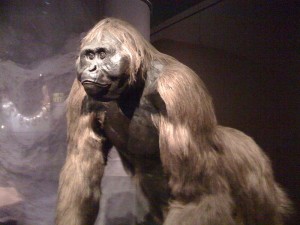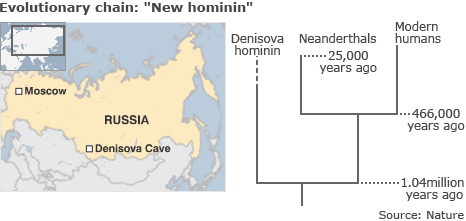DNA test concluded that the finger bone fragment that was found in a Siberian Cave is of an unknown ancient human. If the possibility of human- Homo sapiens, Neanderthals and this mysterious “X-woman”
all interaction can be viewed as quite possible, then I wonder what other hominids we could find?
Ahem…..*cough Gigantopithecus cough*
This brings to mind the “Bering Strait Sasquatch theory” that puts forth the idea of Sasquatch being a descendant of Gigantopithecus. Gigantopithecus having crossed from Asia to the Pacific Northwest through the Bering Strait land mass.
Full source: BBC news
1 commentScientists have identified a previously unknown type of ancient human through analysis of DNA from a finger bone unearthed in a Siberian cave.
The extinct “hominin” (human-like creature) lived in Central Asia between 48,000 and 30,000 years ago.
An international team has sequenced genetic material from the fossil showing that it is distinct from that of Neanderthals and modern humans.
Details of the find, dubbed “X-woman”, have been published in Nature journal.
Ornaments were found in the same ground layer as the finger bone, including a bracelet.
Professor Chris Stringer, human origins researcher at London’s Natural History Museum, called the discovery “a very exciting development”.
“Whoever carried this mitochondrial genome out of Africa about a million years ago is some new creature that has not been on our radar screens so far
Svante Paabo”
Max Planck Institute for Evolutionary Anthropology“This new DNA work provides an entirely new way of looking at the still poorly-understood evolution of humans in central and eastern Asia.”
The discovery raises the intriguing possibility that three forms of human – Homo sapiens, Neanderthals and the species represented by X-woman – could have met each other and interacted in southern Siberia.
The tiny fragment of bone from a fifth finger was uncovered by archaeologists working at Denisova Cave in Siberia’s Altai Mountains in 2008.
An international team of researchers extracted mitochondrial DNA from the bone and compared the genetic sequence with those from modern humans and Neanderthals.
Origin unknown
Mitochondrial DNA comes from the cell’s powerhouses and is passed down the maternal line only.
The analysis carried out by Johannes Krause from the Max Planck Institute for Evolutionary Anthropology in Leipzig, Germany, and colleagues revealed the human from Denisova last shared a common ancestor with modern humans and Neanderthals about one million years ago.
This is known as the divergence date; essentially, when this human’s ancestors split away from the line that eventually led to Neanderthals and ourselves.
The Neanderthal and modern human evolutionary lines diverged much later, around 500,000 years ago. This shows that the individual from Denisova is the representative of a previously unknown human lineage that derives from a hitherto unrecognised migration out of Africa.
“Whoever carried this mitochondrial genome out of Africa about a million years ago is some new creature that has not been on our radar screens so far,” said co-author Professor Svante Paabo, also from the Max Planck Institute for Evolutionary Anthropology.
The divergence date of one million years is too young for the Denisova hominin to have been a descendent of Homo erectus, which moved out of Africa into Asia some two million years ago.
And it is too old to be a descendent of Homo heidelbergensis, another ancient human thought to have originated around 650,000 years ago. However, for now, the researchers have steered away from describing the specimen as a new species.
Dr Krause said the ground layer in which the Denisova hominin fragment was found contain tools which are similar to those made by modern humans in Europe.
Read more: BBC news







